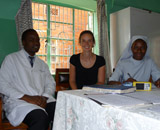 Thousands of well intentioned donations are made to developing countries every year but many of these do not achieve what was hoped; they don’t make it to the intended recipient, or they’re unfit for purpose when they do. I hope I can persuade you that this is not the case for Lifebox oximeters.
Thousands of well intentioned donations are made to developing countries every year but many of these do not achieve what was hoped; they don’t make it to the intended recipient, or they’re unfit for purpose when they do. I hope I can persuade you that this is not the case for Lifebox oximeters.
I was involved in one of the first donations of Lifebox oximeters: 80 pulse oximeters to anaesthetic officers and nurses across Uganda, delivered at a three day training workshop in June 2011.
These donations have been followed-up more intensively than might be expected. Given the difficulties of getting feedback on an intervention even in the UK where we are all readily contactable, the information Lifebox has managed to gain is quite remarkable as well as reassuring. The oximeters are well used and function without problem in the resource-poor environments to which they are donated.
The donation method works
Lifebox aims to build a relationship with the individual anaesthetic provider using the pulse oximeter, as well as with their institution. The pride the providers have in their oximeters limits the potential for it getting lost or damaged, and the sense of ownership by an individual means the oximeters are taken to where they are needed, rather than remaining in a dusty cupboard for example when hospitals stop providing surgery.
The design works
The design of the oximeters is suited to the developing world environment. As I followed up the oximeters, many anaesthetic officers told me how much they valued the long battery life—few of them work in facilities with more than a couple of hours of electricity a day. In recognition of the fact that nothing is indestructible and probes (the most delicate part of an oximeter), in particular, will break, Lifebox oximeters have been designed to accept generic probes which can be acquired locally, prolonging the useful life of the donated oximeter.
They get well used
Early (three to six months) and late (18 month) formal follow-up found that these oximeters are being used up to twenty times a day. On return trips to make further donations we have been met with ongoing enthusiasm for their use both from providers who already have one and those who have heard about them from their colleagues.
Do they make a difference?
There may not be academic proof of the benefits of an oximeter, but we would never anaesthetise a patient in the UK without one—so can we argue their value to patients elsewhere in the world? If you want further reassurance I can offer only representative individual stories from the anaesthesia providers I spoke to:
- Following a caesarean, the anaesthetist was on the other side of the theatre helping to resuscitate the baby (they frequently act as midwife and theatre runner as well). The mother, unnoticed, obstructed her airway. Without the drop in tone of the oximeter as her saturations fell it would have been several (potentially fatal) minutes before this was noticed and corrected.
- Not long after the start of surgery a patient arrested. The pulse and blood pressure are checked only intermittently (manually) and pallor is difficult to see in black skin. Without the continuous monitor of the oximeter, the first sign of loss of output is often when the surgeon notices a lack of bleeding. In this instance, the loss of the waveform on the oximeter alerted the anaesthetist and the patient was quickly and successfully resuscitated.
There are lots of charities making lots of appeals, particularly around Christmas time. I hope I have gone some way to convincing you that these anaesthesia providers, their patients, and the Lifebox appeal are a worthwhile recipient of your generosity.
Louise Finch is an anaesthetics trainee in the Wessex deanery. She delayed commencing her ST3 post by six months and undertook voluntary work with Lifebox in Uganda. She was assisted by a grant from the AAGBI.
Lifebox is the BMJ’s holiday charity this year. For more information, or to donate, see this week’s BMJ or visit www.lifebox.org. The BMJ campaign runs until the end of January.